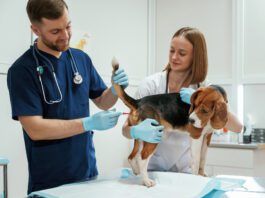Use Caution When Filling Veterinary Prescriptions at Human Pharmacies
A few years ago, I was at my vet’s office when an older couple brought in a Chihuahua puppy who was very ill. Despite the staff’s best efforts, less than an hour later the pup was dead. The cause? A drug overdose, due to a prescription error made by a human pharmacy.
How to Decipher Veterinary Code
What the heck do all those letters mean? They can seem as random as letters in a bowl of alphabet soup. But those acronyms pack a lot of information in just a spoonful. Here’s a guide to deciphering all the letters that you may see that have to do with veterinary professionals.
Alternative Treatment & Supplement Recommendations
Whole Dog Journal readers often try techniques and products described in the magazine, but sometimes years go by before we need something we read about, or it disappears from the market, or we have trouble finding it, or we simply forget all about it. Last month we revisited green tripe, Seacure, and Willard Water. Here are two more go-to products featured in previous issues that might now be perfect for you and your dog, Wobenzym & EMT Gel/Spray.
Essential Oil Tick Repellents: What Works and What Doesn’t
Far be it from us to tell you to put pesticides on your dog. But weve never heard of a single nontoxic preparation that was effective at keeping ticks off all dogs. For some dogs, only the potent pesticides seem to keep ticks away. There are, however, some nontoxic products both commercially produced and homemade formulas that work to repel ticks well enough to consider using them as part of a comprehensive Lyme disease prevention program.
Tick Paralysis: What to Do if Your Dog Seems Paralyzed
Tick paralysis is caused by a neurotoxin produced by egg-engorged female ticks, who transmit the toxin from their salivary glands to the dog during feeding. The production (and transmission) of the toxin is greatest when the tick has been attached to and feeding from the dog between five and seven days. Five species of North American ticks produce the neurotoxin: the blacklegged tick (a.k.a. the deer tick), American dog tick, Rocky Mountain wood tick, the Lone Star tick, and the Gulf Coast tick. Most North American cases occur between April and June, when the ticks are at their peak reproductive activity.
Doxycycline Shortage leaves People and Pets Scrambling for Treatment Alternatives
Drug of choice for treating tick-borne disease and heartworm is unavailable (or unaffordable) due to supply bottleneckWhen my newest search and rescue partner, Cole, fell apart during a certification test in May 2012, I had accumulated enough hard lessons to know my next move. We didn't need to revisit our training protocol or take his nose in for a tune-up. We were at our vet's office the next morning for bloodwork.
Wolves, Dogs, Differ in Ability to Digest Starches
Study finds genetic differences between dogs and wolves, with dietary implications. Domestication appears to have led to genetic changes in dogs that make them able to digest starches better than wolves can, according to a paper published in Nature in January.
Risks and Benefits to Spaying/Neutering Your Dog
When we talk about dogs, invariably we talk about dog people. The human desire to group things that interest us and build commonality among kindred spirits is hardwired - as is our tendency to segregate and highlight differences. As a result, dog people may identify as belonging to as many different canine communities as there are breeds. And within those "tribes," we have mores, and values, and politics - and not all of them are compatible.
Keeping Your Dog Intact
If you decide to delay spaying or neutering your dog, for whatever length of time or whatever reason, here is something else to consider: Some people just may not be cut out to deal with an intact male or female dog in their household. Here are some caveats and considerations.
An Old Infectious Disease Is New Again
It’s baaaaack. News that infectious canine hepatitis surfaced in New England this summer is not exactly on par with the possessed television sets and otherworldly bedroom-closet portals in the 1980s horror flick “Poltergeist.” But the fact that the disease – formally known as canine adenovirus-1, or CAV-1 – has materialized in the United States is likely to induce goosebumps in those who have opted to not vaccinate against it, thinking it was essentially obliterated in the American dog population.
Dogs with the MDR1 Mutation: Drug Sensitivities
Most dog owners are aware that Collies and other herding breeds may be sensitive to ivermectin, used for heartworm prevention and to treat certain parasites. But did you know that these dogs can also be sensitive to a number of other drugs, and that other breeds can also be affected?
Best Treatment Options for Canine Lipomas
Uh-oh. What’s this lump? Any growth on your dog’s body deserves attention, especially one that wasn’t there last time you checked. It could be a sebaceous cyst (a sac filled with sebum, a cheesy or oily material, caused by clogged oil glands in the skin), an abscess (a pus-filled swelling caused by infection), or – everyone’s worst nightmare – a cancerous tumor. But in most cases, the lumps we discover as we pet and groom our dogs are lipomas, which are benign (non-cancerous) fat deposits, also known as fatty tumors. An estimated 1.7 million dogs are treated in the United States for lipomas every year, and according to one survey, American veterinarians average 25 lipoma removals annually at a cost to owners of $635 million. Lipomas tend to emerge as dogs reach middle age and increase in number as dogs get older. A dog with one lipoma is likely to get more. Lipomas are most often found on the chest, abdomen, legs, or armpits (axillae). These fatty lumps aren’t painful and they usually stay in one place without invading surrounding tissue.















